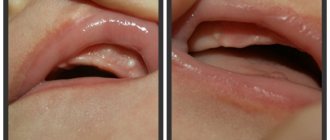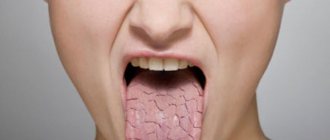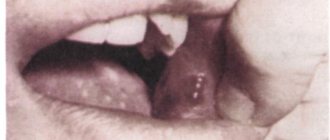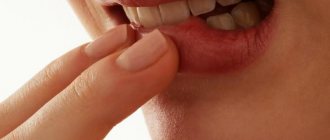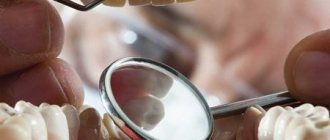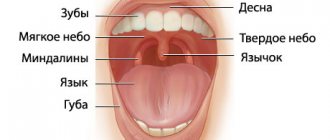Any doctor considers pimples in the throat as a symptom of disease. The pathology may be fungal, bacterial or viral in nature. In most cases, pimples in the throat in an adult or a child occur against the background of diseases of the ENT organs. For each pathology, the rashes have a different color, shape and location, which allows the doctor to quickly establish a diagnosis and begin treatment of the patient. Below are the most likely causes of pimples in the throat.
Laryngitis
This term refers to a disease in which the laryngeal mucosa is damaged. Laryngitis can occur independently or be a consequence of other inflammatory processes affecting the ENT organs.
Pathology can be both acute and chronic. In addition, catarrhal, atrophic, allergic, hypertrophic and diphtheria forms of the disease are distinguished. Each of them has its own specific characteristics.
Common symptoms include the following:
- Dry cough.
- Sore throat.
- Formations that look like pimples.
- Hoarseness in the voice.
- Dry mouth.
- Painful sensations when swallowing.
- Malaise.
- Increased body temperature.
Lumps in the throat, similar to pimples, form with hypertrophic laryngitis. The mucous membrane begins to thicken, and red formations appear on it.
Regardless of the severity of symptoms, treatment of laryngitis should not be delayed. This is due to the fact that ignoring the disease leads to serious complications. The acute form threatens the development of tonsillitis and bronchitis. Chronic laryngitis can provoke the appearance of cysts and tumors of a malignant nature.
Regardless of the intensity of the symptoms, treatment of laryngitis involves:
- Reducing the load on the larynx. In other words, a person is not recommended to talk often and for a long time.
- Exclusion from the diet of foods that irritate the larynx.
- Quitting smoking and drinking alcoholic beverages.
- Drink plenty of warm fluids.
- Lozenges for sore throat.
- Taking expectorants. Cough medications are also indicated.
- Taking antihistamines, antiviral and antibacterial agents.
In some cases, doctors recommend taking a course of physical therapy.
Abscesses
In this case, we are talking about inflammatory foci in the form of purulent formations, which gradually grow and rupture after some time.
An abscess appears anywhere in the human body. However, if we talk about the pharynx, then, as a rule, this disease appears against the background of acute otitis (especially if pus has formed during the course of the disease). If we talk about what provokes such an illness, then most often it is staphylococci, streptococci and E. coli. It is worth noting that most of these bacteria are present by default on the mucous membranes of any organism. However, during their lives they are in the so-called sleep mode. As soon as the human body's immune system fails, bacteria become active and begin to multiply at tremendous speed. At the same time, against the background of their vital activity, serious damage to mucous tissue occurs. Therefore, the development and characteristics of the course of abscesses depend on how well the body’s protective functions work.
If we are talking about an abscess that is observed on the back wall of the throat, then, as a rule, in this case there are additional symptoms. First of all, a person’s temperature rises slightly. He notices that the red pimples on the wall of the throat turn into purulent formations that gradually grow. As they increase, it becomes increasingly difficult to swallow and communicate. There is a stronger secretion of saliva. Additionally, patients note the appearance of foul breath.
It is also worth feeling your neck and assessing how it looks. If it swells, has a reddish tint and becomes hot, then there is every suspicion that an abscess has developed in the back of the throat. However, at the first stage, this pathology is very difficult to determine, since a small abscess is very easily confused with a simple pimple.
Pharyngitis
The causative agent of this disease is most often staphylococcus. The pathology is accompanied by the development of an inflammatory process that affects the inner walls of the pharynx.
Pharyngitis can be both acute and chronic. The latter is divided into hypertrophic and atrophic.
Pathology can develop under the influence of many provoking factors. For example, when inhaling cold air or chemical vapors.
The throat with pharyngitis in adults may not be red. There is no pain in most cases. At the same time, a person feels a sore throat and how a mucous secretion flows down the back wall of the throat. In addition, his body temperature is elevated. A runny nose does not appear with pharyngitis.
In children, the symptoms of the disease are more pronounced. As a rule, their pharyngitis is a consequence of an untreated respiratory infection. Distinctive signs of the disease in a child are red pimples in the throat, hyperemia, painful sensations, often radiating to the ears.
Most often, pharyngitis affects children who spend most of their time indoors with dry and warm air.
If the disease occurs against the background of another pathology, all therapeutic measures are aimed at eliminating the root cause. For bacterial pharyngitis, antibiotics are indicated. If the disease is viral in nature, doctors recommend limiting yourself to gargling. If necessary, antipyretic and painkillers may be taken.
Angina
Another name for the pathology is acute tonsillitis. This is an infectious disease that affects the tonsils, back wall of the pharynx and soft palate. The causative agents can be bacteria, viruses, and fungi.
Pimples in the throat are observed in the following forms of the disease:
- Herpetic. The causative agent is a virus. Patients complain of severe pain, aggravated by swallowing, runny nose and high body temperature. The latter often reaches critical levels. Upon examination, the doctor discovers red pimples in the throat. The tonsils are also covered with ulcers. The rashes are filled with grayish liquid.
- Follicular. This form is developing rapidly. A person’s body temperature rises and he complains of unbearable pain. With follicular sore throat, the throat is very inflamed. In addition, the tonsils greatly increase in size. You can also find white pimples in the throat (in both children and adults).
- Peritonsillar abscess. The patient's body temperature rises, he is worried about chills, and his lymph nodes are enlarged. First, a white pimple forms in the throat. Over time it increases in size. The follicle is opened exclusively by surgery.
Sore throat requires quick treatment. In its absence, after 5-7 days it turns into chronic tonsillitis. The treatment regimen involves the use of local remedies (Hexoral, Ingalipta), taking antihistamines (Eriusa, Claritina), drinking plenty of fluids, and gargling. If necessary, antipyretic medications are indicated. Bacterial sore throat requires antibiotics.
Emerging diseases
Pimples in the throat can be the first sign of the occurrence of such diseases:
- tonsillitis;
- scarlet fever;
- bacterial pharyngitis;
- candidiasis;
- stomatitis.
The above diseases pose a serious threat to the human body. Incorrect treatment and lack of medication lead to death. You need to immediately pay attention to education.
Angina
Sore throat (acute tonsillitis) is determined when plaque appears on the tonsils. Characterized by fever, acute pain in the tonsils. The appearance of plaque is a distinctive feature of the disease. There are different types of sore throat. The complexity of treatment depends on the type. Inflammation that occurs in the tonsils prevents you from breathing, drinking, or eating calmly. Acute pain that occurs upon any contact with food or water brings painful sensations.
- White plaque in the throat in a child or adult - causes of appearance, means of treatment
Most often, catarrhal tonsillitis develops. The patient complains of pain in the tonsils, severe burning, dry mouth, and fever. The plaque on the tonsils is not very large. Treatment is carried out for two weeks with antibiotics, sometimes a drip is prescribed in case of elevated temperature.
Follicular tonsillitis may appear, characterized by an increase in body temperature to thirty-nine degrees Celsius. The pain when swallowing becomes more acute. It often goes into the ear. Due to an infectious inflammatory process, partial hearing loss begins. Lymph nodes double in size. Fever causes body aches.
The lacunar type has similar symptoms to the follicular type. It comes with complications. White pimples turn yellow due to the large amount of pus.
The fibrinous type is characterized by the elimination of acne and the flow of pus. An inflammatory process occurs. A yellow plaque settles in the tonsils, exposing the body to infection. My throat starts to hurt. Plaque gives rise to a strong inflammatory process. Fever is an integral feature of the disease.
Scarlet fever
Scarlet fever is an infectious disease. They warn about the occurrence of pimples on the throat. When they occur, a white coating appears on the tongue. Scarlet fever can be contracted from someone with tonsillitis. A person is dangerous in the first days of illness. It is worth limiting contact with a healthy person who has recovered from the disease. Can be a carrier for a month. You can get infected from a healthy person. A certain percentage of people have scarlet fever. The disease develops without symptoms and does not cause discomfort to the carrier. Bacteria can be released when you sneeze or cough. It is worth regularly (twice a year) to take a culture test for the presence of streptococcus bacteria.
When the disease manifests itself, general intoxication of the body occurs. The immune system weakens, body temperature rises. A characteristic rash appears on the tongue and pimples around the mouth. Formed after three days. It can appear not only on the tongue, but throughout the body: under the arms, on the bends of the knees, arms. Scarlet fever has similar manifestations of tonsillitis. Only a few symptoms add up. The skin begins to peel off. Lack of vitamins causes dry skin. The dermis becomes pale and dry. The tongue is bright red. They call it “raspberry” tongue.
Bacterial pharyngitis
Occurs at the end of winter, beginning of autumn. The period is characterized by a weakening of the immune system. The body is exposed to a variety of viruses. Pharyngitis is characterized by inflammation of the mucous membrane of the throat, enlargement of the lymph nodes, causing pain. Pimples on the throat can signal the appearance.
The cause may be polluted, hot air inhaled daily. Irritation of the mucous membrane occurs. The result is pharyngitis. The nasopharynx is often affected. The disease is accompanied by a runny nose, which does not go away for a long time, transforming into rhinitis, sinusitis. Disease of the tonsils, ears, nose are interconnected. Problems arise for one, and another begins to get sick. Logical pattern.
- What to do if you find ulcers in the throat without fever
Candidiasis
Candidiasis is a fungal infection that affects not only the larynx, but the body as a whole (detailed material). Affects the oral cavity. A characteristic feature is a white tongue. It can manifest itself for a variety of reasons. Common – abuse of antiseptics, lack of vitamins, overdose of antibiotics. These products kill beneficial bacteria in the body. Provoke fungus to grow. Contains the necessary enzymes for the development of fungal disease.
At the initial stage, symptoms are not noticeable. Sometimes dry mouth appears and the temperature rises slightly. Weakness and malaise occur. Less often - sore mouth. The symptoms are similar to normal respiratory inflammation. Almost no one goes to the doctor with such a diagnosis, considering it a trifle. Symptoms can be aggravated by eating sour, hot foods. The mucous membrane of the throat becomes more irritated. A real illness is emerging.
The advanced form has pronounced purulent discharge. Pimples on the back of the throat are characteristic manifestations of candidiasis. The disease may appear in the form of grains. The formations will stand out clearly, having a bright red color. It can be seen especially clearly when coughing or observing the throat under a light. By visiting a doctor quickly, without preliminary tests, you can find out the result of the examination. After passing the necessary tests, confirm the result.
Stomatitis
Affects the oral mucosa. It appears as white wounds. On contact it causes pain and burning. Occurs due to mechanical damage and dysfunction of the body. It can be a burn caused by eating sour or hot foods. Signals about health problems.
Most often occurs due to swelling of the lymph nodes. Characterized by bad breath, bleeding gums, and a pimple in the throat. In advanced cases, plaque can form on the tongue. Manifestation of stomach problems. Ulcerative formations appear on the inside of the cheeks and lips. Contact with salty, sour foods causes severe pain. The formation is covered with a white, protective film. It goes away after eliminating the problem with nutrition and putting the natural metabolism in order.
Allergic reaction
Its clinical manifestations are similar to colds. Allergies can occur at any time of the year. It is always a consequence of irritation of the respiratory tract by provoking agents (for example, animal hair or plant pollen).
Allergy symptoms:
- Redness of the uvula and palate.
- Small pimples in the throat (without fever or pain).
- Soreness.
- Feeling of a lump in the throat.
- Cough.
- Hoarseness in the voice.
- Runny nose.
Allergies must be treated. Ignoring pathology can lead to the development of bronchial asthma. In addition, the disease often becomes chronic.
Treatment of allergies involves taking immunomodulators and antihistamines. Most often, doctors recommend taking Erius, Tavegil and Claritin. According to indications, glucocorticoids may be prescribed.
Preventive measures
To avoid throat problems, you must often be in the fresh air. When a person inhales abundantly, the mucous membranes of his respiratory tract are moistened and well coated with saliva, which has an antibacterial effect.
To maintain health, you need to drink enough water, eat a quality and balanced diet, and take vitamins. You should definitely give up bad habits, especially smoking, which causes severe damage to the mucous membranes of the pharynx.
It is useful to harden yourself, adhere to a certain daily routine, and take a contrast shower. It is not advisable to use antibiotics frequently. These medications are addictive.
Scarlet fever
This is an infectious disease caused by hemolytic streptococcus. It is characterized by the development of an inflammatory process that affects the mucous membranes of the oral cavity. Infection occurs after contact with a carrier who has pharyngitis or tonsillitis.
The first signs include: increased body temperature and painful sensations in the throat. The next day a rash appears on the skin. At the same time, the nasolabial triangle remains absolutely clean and untouched. Upon examination, you can also find small red pimples in the throat. The tongue takes on a crimson hue and its surface becomes grainy.
The basis of treatment is antibiotics. As a rule, doctors prescribe Amoxiclav, Ampicillin, and Phenoxymethylpenicillin. The duration of treatment is from 7 to 10 days. In most cases, the infection is mild. Visible improvements occur almost immediately after starting antibiotic therapy.
To completely destroy streptococcus, B vitamins and ascorbic acid are additionally prescribed. If the course of treatment is not completed completely, the person becomes a carrier of the infection and poses a danger to others.
Locations of acne in the throat
Pimples in the throat in infectious diseases are often located on the back wall. The favorite place of localization of fungi is on the tongue and its root. White pimples in a child's throat are clearly visible on the tonsils.
Widespread hyperemia of the mucous membranes of the soft palate and uvula is observed with inflammation of the nasopharynx. Stomatitis affects the gums.
The rash due to childhood infections is also located on the inner walls of the cheek, the tonsils. Diseases of the ENT organs are accompanied by pimples in the throat on the back wall.
Candidiasis
Another name for the disease is thrush. As a rule, it develops against the background of a weakening of the body's defenses. It is most often diagnosed in the oral cavity of infants.
Thrush in all cases is accompanied by the appearance of pimples in the throat. Moreover, they are always covered with a white coating that has a cheesy consistency. The rashes are localized on the soft palate, tonsils, tongue and behind the arches. If you try to remove the plaque yourself, you may find pimples underneath, from which a small amount of blood is released.
In addition, symptoms of thrush are:
- Painful sensations in the throat.
- Dry mouth.
- Burning and itching.
- Redness of the throat.
- Enlarged tonsils.
- Loss of appetite.
- Increased body temperature (in children, in adults it rarely increases).
If treatment is not started in a timely manner, complications develop against the background of candidiasis. In place of pimples, ulcers form, which over time begin to fester. In addition, the infection through the bloodstream can spread throughout the body, affecting all its systems. Yeast-like fungi (the causative agent of thrush) can provoke the development of sepsis, which often ends in death.
Treatment of thrush involves taking systemic antifungal agents. As a rule, doctors prescribe the following drugs: Intraconazole, Fluconazole, Fucis, Mycostatin. The choice of medication is made by a specialist based on the diagnostic results and taking into account the severity of the disease.
In addition, if you have thrush, you need to rinse your mouth with oak infusion or boric acid. The affected areas should also be treated with sea buckthorn oil, Fukortsin or Lugol solution.
If there are red bumps on the tongue closer to the throat
It is worth noting that the tongue is an extremely important organ, which is used not only for the functioning of the speech apparatus, but is also an excellent “analyzer” of food. Thanks to the tongue, chewing of food and its primary processing are ensured.
On the surface of this organ there are a large number of papillae, barely visible to the eye. They are quite sensitive, so they become inflamed easily. As a result, pimples appear on the tongue closer to the throat. In this case, the most common cause of such irritation is a burn (chemical or thermal type) or injury to the organ itself.
This can also happen due to allergic reactions. For example, pimples on the tongue closer to the throat may appear with stomatitis or with the development of vitamin deficiency. If the human body suffers from a lack of vitamin B12, then in this case the entire tongue turns red and begins to resemble strawberries in appearance.
There is also a disease called glossitis. If the patient suffers from an advanced form of this disease, then ulcers may also form on the root of the tongue.
Stomatitis
The causative agent of the disease is the herpes virus. Children under 3 years of age are most susceptible to the disease. Stomatitis is an inflammation of the mucous membrane in which it is impossible to eat due to unbearable painful sensations.
In addition, the following conditions are signs of stomatitis:
- Pimples in the throat. They may differ in both shape and shade. On the outside they are covered with a yellowish coating.
- Hyperemia of the pharyngeal walls.
- Ulcers localized on the inside of the cheeks.
- Jams. Cracks appear in the corners of the mouth.
The basis of treatment for stomatitis is the use of antiviral drugs. The choice of medication directly depends on the patient’s age and the severity of the disease. In addition, in case of pathology it is necessary to take immunostimulating agents. In this case, it is allowed to resort to traditional medicine methods. For example, Echinacea and Chinese Schisandra significantly help strengthen the body’s defenses.
To relieve a sore throat, you need to suck on the lozenges. As a rule, doctors prescribe the following drugs: Septolete, Sebidin, Faringosept. In addition, rinsing the mouth with antifungal solutions is indicated. The most effective drug is Candide.
ethnoscience
A red throat, red bumps on the tongue and severe pain cause a lot of discomfort. When it comes to children, parents prefer to do without antibiotics and other aggressive agents. In addition, in this situation, you should not use rinses that cannot be swallowed. Although traditional medicine methods are considered quite gentle, they do not always demonstrate high effectiveness. Therefore, such methods should not be used as the main treatment.
If pimples appear on your throat and your throat hurts, you should consult your doctor. If it allows additional treatment, then it is worth using several recipes.
First of all, it is worth preparing an infusion from a collection consisting of chamomile, linden and eucalyptus leaves. Pour 1 tablespoon of the medicinal mixture into a glass of boiling water and leave for half an hour. After this, the mixture is filtered and used for rinsing once a day.
If a child has pimples on the wall of his throat, then it is worth using products that, even if swallowed, cannot harm the stomach. For example, you can use kombucha. Not only is it a delicious drink, but it also has anti-inflammatory and analgesic properties. You can not only drink it, but also use it for rinsing. You can also make beet juice by adding a little lemon to it.
There is also another popular recipe. To prepare a remedy for inflammation of the mucous membrane, you need to boil half a glass of milk and add a teaspoon of butter and half a teaspoon of soda to it. Additionally, you can add a pinch of ginger powder. The resulting composition is used for rinsing. After this, you can eat a little natural honey, slowly dissolving it.
Inhalations demonstrate quite high efficiency. They can be performed by both adults and children. For example, you can mix chamomile and sage herbs. One tablespoon of raw material is poured into 1 liter of boiling water. After this, the liquid is cooled slightly so as not to burn the delicate mucous membrane. After some time, you need to breathe through your mouth over the steam for 5 - 10 minutes. To increase the effectiveness of the procedure, it is recommended to cover your head with a towel. Propolis can also be used for inhalation procedures. In this case, one tablespoon of raw material is also poured with a liter of boiling water and cooled slightly.
If we are talking about children, it is important to ensure that they do not suffer damage to the upper respiratory tract. Therefore, you need to make sure that the steam is not too hot. Also, such activities are strictly prohibited if the patient has a fever.
Yoga adherents have also found a way to get rid of irritation in the throat. For this they recommend the lion pose. This exercise ensures a rush of blood to the throat. This way you can relieve some inflammation and get rid of pain.
Infectious mononucleosis
This term refers to a contagious disease of a viral nature. As a rule, it is transmitted by airborne droplets. The entry point for infection is the oral cavity. The virus then spreads throughout the body.
The onset of the disease is acute. Patients experience:
- Enlarged lymph nodes.
- Fever.
- Hyperemia of the pharynx.
- Rashes in the throat.
- Hyperplasia of the tonsils.
- Fever.
- The coating on the tongue is grayish-white.
- Swelling of the face.
- Nosebleeds.
- Labored breathing.
At any stage of the pathology, there is a high probability that a sore throat or stomatitis may develop. At the same time, taking medications intended to get rid of these ailments does not immediately lead to a positive result.
Currently, there is no specific therapy for the pathology. In severe cases, taking antibiotics or antibacterial agents in combination with corticosteroids, vitamins and antihistamines is indicated.
If you have mononucleosis, you need to regularly rinse and irrigate your mouth. As a rule, doctors prescribe the following drugs: “Furacillin”, “Stopangin”, “Rivanol”, “Ectericide”, “Collustan”. If there is an ulcerative-necrotic complication, treatment is carried out according to the stomatitis treatment regimen.
Diphtheria
This is an infectious disease. The pathogen is transmitted to a healthy person by airborne droplets. Diphtheria is an inflammatory process that involves the mucous membranes of the nasopharynx and oropharynx, as well as the organs of the nervous, cardiovascular and excretory systems.
Clinical manifestations and their severity directly depend on the severity of the disease. Common symptoms include the following:
- Swelling of the mucous membrane.
- Pimples in the throat, covered with a film.
- Hoarseness of voice.
- Severe pain in the throat.
- Enlarged lymph nodes. Edema also forms around them. In such cases, doctors use the term “bull neck”.
- Too frequent or, on the contrary, difficulty breathing.
- Nasal discharge.
- Chills.
- Fever.
- A state of general malaise.
Diphtheria is a dangerous disease that has many forms. Some of them can be fatal. In addition, serious complications often develop as the disease progresses. Moreover, they can occur both during the course of the disease and several months after complete recovery.
The most likely consequences of diphtheria:
- Myocarditis.
- Damage to the adrenal glands.
- DIC syndrome.
- Respiratory failure.
- Nephrosis of a toxic nature.
- Heart failure.
- Pneumonia.
- Otitis.
- Infectious-toxic shock.
- Peritonsillar abscess.
Treatment of the disease is carried out exclusively in a hospital setting. Immediately after confirmation of the diagnosis, the patient is administered antitoxic serum intravenously or intramuscularly. In addition, taking antibacterial drugs is indicated. Most often, doctors prescribe the following drugs: Erythromycin, Ampiox, Tetracycline, Ampicillin, Penicillin.
In addition, it is important to reduce the degree of intoxication of the body. For this purpose, the administration of a potassium mixture, polyionic solutions and glucocorticoids is prescribed. In some cases, plasmapheresis is performed.
